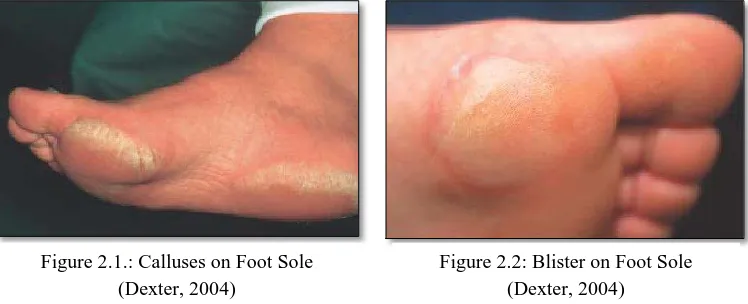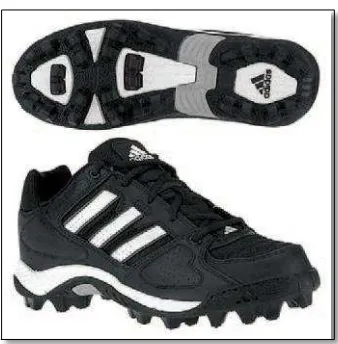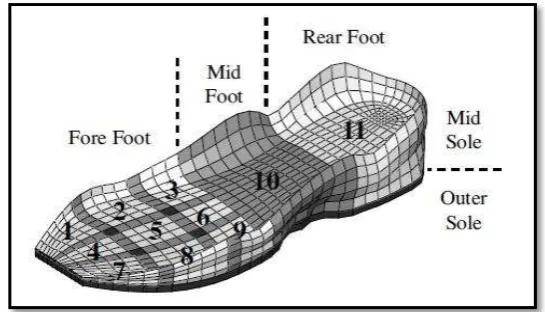UNIVERSITI TEKNIKAL MALAYSIA MELAKA
ERGONOMIC DEVELOPMENT OF SHOE SOLE DESIGN
This report submitted in accordance with requirement of the Universiti Teknikal Malaysia Melaka (UTeM) for the Bachelor Degree of Manufacturing Engineering
(Manufacturing Design)
by
NUR SYUHADA BINTI HASIMUDDIN
B050910133
900120045144
UNIVERSITI TEKNIKAL MALAYSIA MELAKA
BORANG PENGESAHAN STATUS LAPORAN PROJEK SARJANA MUDA
TAJUK: Ergonomic Development of Shoe Sole Design
SESI PENGAJIAN: 2012/13 Semester 2
Saya NUR SYUHADA BINTI HASIMUDDIN
mengaku membenarkan Laporan PSM ini disimpan di Perpustakaan Universiti Teknikal Malaysia Melaka (UTeM) dengan syarat-syarat kegunaan seperti berikut:
1. Laporan PSM adalah hak milik Universiti Teknikal Malaysia Melaka dan penulis. 2. Perpustakaan Universiti Teknikal Malaysia Melaka dibenarkan membuat salinan
untuk tujuan pengajian sahaja dengan izin penulis.
3. Perpustakaan dibenarkan membuat salinan laporan PSM ini sebagai bahan pertukaran antara institusi pengajian tinggi. atau kepentingan Malaysia sebagaimana yang termaktub dalam AKTA RAHSIA RASMI 1972)
(Mengandungi maklumat TERHAD yang telah ditentukan oleh organisasi/badan di mana penyelidikan dijalankan)
DECLARATION
I hereby, declare this thesis entitled
“ERGONOMIC DEVELOPMENT OF SHOE SOLE DESIGN”
is the result of my own research except as cited in the reference.
Signature : ...
Author’s Name : NUR SYUHADA BINTI HASIMUDDIN
APPROVAL
This report is submitted to the Faculty of Manufacturing Engineering of UTeM as a partial of the requirements for the degree of Bachelor of Manufacturing Engineering
(Manufacturing Design). The member of the supervisory committee is as follow:
i
ABSTRAK
ii
ABSTRACT
Proper selection of athletic shoes is important for sports related activities to ensure improved athletic performance. The problem that always happened is inadequate data foot measurement for Malaysian population and injuries happened among the athletes. Therefore, there is the need to consider the design requirement for different sports and different foot profile. The objectives of this study are to obtain the anthropometry data of feet profiles for UTeM students, to develop an ergonomic design of shoe sole for UTeM students and to analyse the contact stress of the shoe sole design for UTeM sportsmen. The scope incorporated in this study is collecting anthropometry data using visual graphic measurement. Based on the anthropometry data, the design of inner shoe sole has been done for three foot profile which is normal, high- arch and flat foot print. Then, the analysis of stress distribution and displacement is done in comparing the material, rubber versus ethylene vinyl acetate (EVA) and three type of foot profile. This study found that, flat inner shoe sole recorded the highest maximum stress distribution (28.1301 MPa) and displacement (664.639 mm) for running sports activities whereas for soccer sports activities, the highest maximum stress distribution is high-arch inner shoe sole (572.294 MPa) and maximum displacement is normal inner shoe sole (49413.8 mm). The analysis also found that, rubber material resulted to lower stress distribution (27.889 MPa) and greater maximum displacement (379.141 mm) compared to ethylene vinyl acetate (EVA) material (28.077 MPa, 96.7997 mm). The significance of this study is the anthropometry data of foot will be useful for shoe manufacturers to develop their shoe design for Malaysian athletes. Besides that, the new designs of inner shoe sole are useful for an improved athletic performance as well as reduce injuries of foot due to sports activities.
iii
DEDICATION
iv
ACKNOWLEDGEMENT
I would like to offer my deepest gratitude to my supervisor, Miss Masni-Azian Binti Akiah from the bottom of my heart for all the support, encouragement and inspirations manage to obtain all the way through of this project study. The working relationship between my supervisor and me has provided a lot of knowledge and experience. The help from my supervisor is priceless for me. Last and not least, my highest thankfulness is dedicated to my beloved family members, friends and other parties whom helped me directly or indirectly.
v
List of Abbreviations, Symbols and Nomenclatures xii
CHAPTER 1: INTRODUCTION 1
3.4 Anthropometry Data Collection 19
3.5 Design of Shoe Sole 19
vi
3.7 Data Analysis 21
CHAPTER 4: PRELIMINARY RESULT 22
4.1 Anthropometry Data of Foot 22
4.2 Design of Inner Shoe Sole for sports Use 26
4.3 Analysis of Inner Shoe Sole 29
4.3.1 Running Inner Shoe Sole 29
4.3.1.1 Maximum Stress of Running Inner Shoe Sole 30 4.3.1.2 Maximum Displacement of Running Inner
Shoe Sole 36
4.3.2 Soccer Inner Shoe Sole 41
4.3.2.1 Maximum Stress of Soccer Inner Shoe Sole 30 42 4.3.2.2 Maximum Displacement of Soccer Inner
vii
LIST OF TABLES
2.1 Specifically Shoe Fitting for Soccer and running Sports 9 2.2 Critical Requirement of Soccer and Running Sports 9
2.3 Anthropometric Data for Foot 11
viii
3.1 Methodology Flow Chart 13
3.2 Spotcheck SKD-S2 Developer Cover the Foot 14
3.3 The Foot in 3D Cad using Direct Scanning 15
3.4 Foot Profile with Modelling Clay 15
3.5 Foot Profile covers with Spotcheck SKD-S2 Developer 15
3.6 Scanning Process 16
3.7 The Foot in 3D Cad using Indirect Scanning 16
3.8 The Glass Table 17
3.9 Foot’s Respondents on the Glass Table 17
3.10 The Foot in Visual Graphic Measurement 17
3.11 Side View of Foot Captured using Visual Graphic Measurement 17
3.12 Structure of Glass Table 18
3.13 Measurement of Foot using “Analyzing Digital Images” Software 18
3.14 Measure of Foot Length using Anthropometer 19
3.15 Measure of Foot Breadth using Anthropometer 19
3.16 Types of Foot Flat, Normal and High Arch 20
3.17 Force Distribution during Running Activity 20
ix
4.1 Bottom of Foot Profile 22
4.2 Side of Foot Profile 22
4.3 Design of Three Types Inner Shoe Sole of Male for Normal,
High-arch and Flat 27
4.4 Design of Three Types Inner Shoe Sole of Female for Normal,
High-arch and Flat 28
4.5 Deformation Scale 29
4.6 Maximum Stress of Male Running Inner Shoe Sole 30
4.7 Rubber versus EVA for Male Normal Foot 31
4.8 Rubber versus EVA for Male High-arch Foot 31
4.9 Rubber versus EVA for Male Flat Foot 31
4.10 Normal, High-arch and Flat Inner Shoe Sole (Male) using
Rubber Material 32
4.11 Normal, High-arch and Flat Inner Shoe Sole (Male) using
EVA Material 32
4.12 Maximum Stress of Female Running Inner Shoe Sole 33
4.13 Rubber versus EVA for Female Normal Foot 34
4.14 Rubber versus EVA for Female High-arch Foot 34
4.15 Rubber versus EVA for Female Flat Foot 34
4.16 Normal, High-arch and Flat Inner Shoe Sole (Female) using
Rubber Material 35
4.17 Normal, High-arch and Flat Inner Shoe Sole (Female) using
EVA Material 35
4.18 Maximum Displacement of Male Running Inner Shoe Sole 36
4.19 Rubber versus EVA for Male Normal Foot 37
4.20 Rubber versus EVA for Male High-arch Foot 37
4.21 Rubber versus EVA for Male Flat Foot 37
4.22 Normal, High-arch and Flat Inner Shoe Sole (Male) using
Rubber Material 38
4.23 Normal, High-arch and Flat Inner Shoe Sole (Male) using
EVA Material 38
4.24 Maximum Displacement of Female Running Inner Shoe Sole 39
x
4.26 Rubber versus EVA for Female High-arch Foot 40
4.27 Rubber versus EVA for Female Flat Foot 40
4.28 Normal, High-arch and Flat Inner Shoe Sole (Female) using
Rubber Material 41
4.29 Normal, High-arch and Flat Inner Shoe Sole (Female) using
EVA Material 41
4.30 Maximum Stress of Male Soccer Inner Shoe Sole 42
4.31 Rubber versus EVA for Male Normal Foot 43
4.32 Rubber versus EVA for Male High-arch Foot 43
4.33 Rubber versus EVA for Male Flat Foot 43
4.34 Normal, High-arch and Flat Inner Shoe Sole (Male) using
Rubber Material 44
4.35 Normal, High-arch and Flat Inner Shoe Sole (Male) using
EVA Material 44
4.36 Maximum Stress of Female Soccer Inner Shoe Sole 45
4.37 Rubber versus EVA for Female Normal Foot 46
4.38 Rubber versus EVA for Female High-arch Foot 46
4.39 Rubber versus EVA for Female Flat Foot 46
4.40 Normal, High-arch and Flat Inner Shoe Sole (Female) using
Rubber Material 47
4.41 Normal, High-arch and Flat Inner Shoe Sole (Female) using
EVA Material 47
4.42 Maximum Displacement of Male Soccer Inner Shoe Sole 48
4.43 Rubber versus EVA for Male Normal Foot 49
4.44 Rubber versus EVA for Male High-arch Foot 49
4.45 Rubber versus EVA for Male Flat Foot 49
4.46 Normal, High-arch and Flat Inner Shoe Sole (Male) using
Rubber Material 50
4.47 Normal, High-arch and Flat Inner Shoe Sole (Male) using
EVA Material 50
4.48 Maximum Displacement of Female Soccer Inner Shoe Sole 51
4.49 Rubber versus EVA for Female Normal Foot 52
xi
4.51 Rubber versus EVA for Female Flat Foot 52
4.52 Normal, High-arch and Flat Inner Shoe Sole (Female) using
Rubber Material 53
4.53 Normal, High-arch and Flat Inner Shoe Sole (Female) using
xii
LIST OF ABBREVIATIONS, SYMBOLS AND
NOMENCLATURE
% - Percent
3D - Three Dimensional
NG - Not Good
FYP - Final Year Project
1
CHAPTER 1
INTRODUCTION
1.1 Project Background
Proper selection of athletic shoes is important for sports related activities to ensure improved athletic performance. Good structural designs of athletic shoes are able to provide adequate support to the foot and prevent musculoskeletal injuries. The design of the shoe soles itself should be able to reduce stress and impact exerted onto the feet due to different sports activities. Repeated or continuous contact between the feet with the shoes will result to varying contact stress. Thus, different sports activity will exhibit different stress effect.
2 The anthropometry data collected in this study will be useful for shoe manufacturers to develop their shoe design for the Malaysian athletes. Further stress analysis can be simulated based on these data and the new designs are useful for an improved athletic performance as well as reduce injuries of foot due to sports activities.
1.2 Problem Statement
The problem that always happened in this shoe sole design is the inadequate data of foot measurement for Malaysian population. Inaccurate selection of shoes size will cause the foot to be injured. Among the foot related injuries due to inappropriate use of shoes will are blisters on the foot, calluses on the sole and ankle sprains (Saluta & Nunley, 2010; Dexter, 2004). Furthermore, inappropriate selection of shoe size will result to lack of stability and reduced athletic performance of the user. Other than that, it may also cause musculoskeletal disorder among the user which will affect the overall posture and performance of the athletes. In addition, different sports activities will cause different stress distribution with varying impact on the foot profile. Therefore, there is the need to consider different design requirement due to different foot profile such as flat, normal and high arched foot.
1.3 Objectives
Based from the problems highlighted above, the objectives of this study are:
3
1.4 Scope of Study
The scopes that are covered in this study are as below:
(a) The anthropometry data of feet collected focuses on UTeM students’ adult age 18 to 30 years old.
4
CHAPTER 2
LITERATURE REVIEW
2.1 Injuries Related to Foot during Sports Activities
Traumatic injuries frequently occur at foot and ankle in most sports activities. From the research in multispecialty sports clinic, 25% of 12,681 injuries are involving to foot and ankle during sports activities (Saluta & Nunley, 2010). According to Young et.al (2005), the foot and ankle are important as the main interface between the ground and body during walking and they are required to absorb impact loading forces, give efficient propulsion and adapt with the segregated ground which is consists 26 main bones in other to accomplish this task.
Soccer is the most popular sport in the world wide (Braver et.al, 2003). In addition, the most commonly injuries happened in soccer sports are ankle sprains (Manning et.al, 2006). The football player is also usually had their injuries related to mid-foot or Lisfranc sprains by a sudden rotation of a planted foot or an axial load on a plantar flexed foot (Saluta & Nunley, 2010).
The runners have high rates of running injuries between 30% and 75% per year for a distance running (Daoud et.al, 2012). According to Shorten & Ph (2000), runner experiences approximately 25,000 impacts of the ground during marathon. The
repeated impact loading of the runner’s body causes overuse injury. The impact also
5 On the other hand, the runners are exposed to stress fracture due to high repetition and low impact activities. These are caused by poorly cushioned shoes and stiff running surfaces (Saluta & Nunley, 2010).
Apart from that, calluses can form on soles of feet and palm as shown in Figure 2.1. Calluses at foot sole commonly form on the weight bearing areas and when it becomes too thick, it will cause discomfort to the individual. Apart from that, blisters also can form and occur on the soles because of the repeated friction as shown in Figure 2.2 which commonly happened when wearing a new pair of shoes (Dexter, 2004). Thus, the callus and blisters formation on the foot sole can be minimised with properly fitted shoes.
2.2 Sports Shoe Designs Consideration
For the soccer shoes, cleats provide an important role to give support in mid foot area and traction to the feet during playing. The cleats can give increased speed and manoeuvrability. The design for soccer cleat is important according to weather conditions, field types and skill levels (Caselli, 2006).
Figure 2.1.: Calluses on Foot Sole (Dexter, 2004)
6 As stated by Logan et al. (2010), fixation rotation can be reduced through design consideration of shoe cleats. It is proposed that height of cleat were to be minimized while maximizing the number of cleats and its diameter. Furthermore, the moulded rubber cleats as shown in Figure 2.3 are usually designed for shoes which are
Figure 2.3: Moulded Studs of Soccer Shoe (Caselli, 2006)
As stated by Caselli (2006), the runners will spend 800 times per mile during running
and the force will be three times the weight of runner’s body. There are five critical
components that should be considered which are the last, outer sole, heel counter, midsole and upper. However, the scope of this project will focus more on the midsole and outer sole.
7 In addition, the important requirements for sport shoes including the design, cushioning, stability, grip, fitting, flexibility, weight, durability and air permeability. The mid sole and outer sole are commonly made of ethylene vinyl acetate (EVA) foam and rubber. From Figure 2.4, mid sole is categorized in three areas which are fore foot (zone 1 to 9), mid foot (zone 10) and rear foot (zone 11) (Shimoyama et al., 2010).
Figure 2.4: Sole Structure (Shimoyama et al., 2010)
8
Figure 2.5: Rigid High Arch Foot, Normal Arch and Low Arch Flexible Foot
(Source: < http://www.edgeandwax.co.uk > 08 December 2012)
Harder soles offer less cushioning, wear longer and will be heavier (Caselli, 2006). For the soft soles, it wears out faster but provide more cushioning and have lighter weight. On the other hand, the midsole is also important because it can absorb shock, provide stability and flexes at toe-off as shown in Figure 2.6. Gel air, bags and other materials are used to increase the cushioning. However, when exposed to cold temperature, the material will lose its cushioning ability. Thus, running shoe can take consideration in cushioning, stability and motion control (Caselli, 2006).
Figure 2.6: Example of Flexes at Toe-Off Shoe



